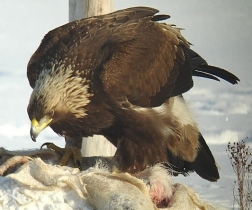|

Large raptor
with dark brown body and golden-brown feathers on back of head and nape.
Eyes and bill are dark. Cere is yellow. Legs are completely feathered.
Feet are yellow. Alternates deep slow wing beats with glides, soars
on thermals. Has been clocked in a steep glide at 120 mph.
|
GOLDEN
EAGLE
Aquila chrysaetos
FALCONIFORMES
Kites, Eagles and Hawks (Accipitridae)
Range and Habitat
Golden Eagle: Occurs worldwide across boreal regions of the globe. In
North America, it breeds from Alaska eastward across the Canadian arctic
to northern Labrador, but is absent from most of Keewatin and the arctic
archipelago. In the west, it occurs south to Baja and northern Mexico,
including all of the western U.S. Found in a variety of habitats in
the western U.S., including mountainous areas, canyons, shrub lands,
and grasslands.
SOUND: "bark", "keya", "mews"
Golden Eagles are protected in the United States where possession of
a feather or other body part is a felony.
In some countries they are trained as hunters and have been reported
to prey on animals weighing up to 100 lbs.
The scientific name Aquila chrysaetos is from the Latin word "aquila"
meaning eagle and from the Greek words "chrysos" and "aetos"
meaning golden and eagle respectively.
A group of eagles has many collective nouns, including an "aerie",
"convocation", "jubilee", "soar", and
"tower" of eagles.
The Golden Eagle is evaluated as Least Concern. This bird is native
to much of the world and has a range that of 1 million kilometers. The
population of the Golden Eagle is believed to a quarter of a million
individual birds. The previous rating for the Golden Eagle was Lower
Risk. That rating was downgraded to Least Concern in 2004 due to the
range as well as the population of this bird. The population of the
Golden Eagle is considered stable enough at this point in time for there
to be no immediate need for concern.

|